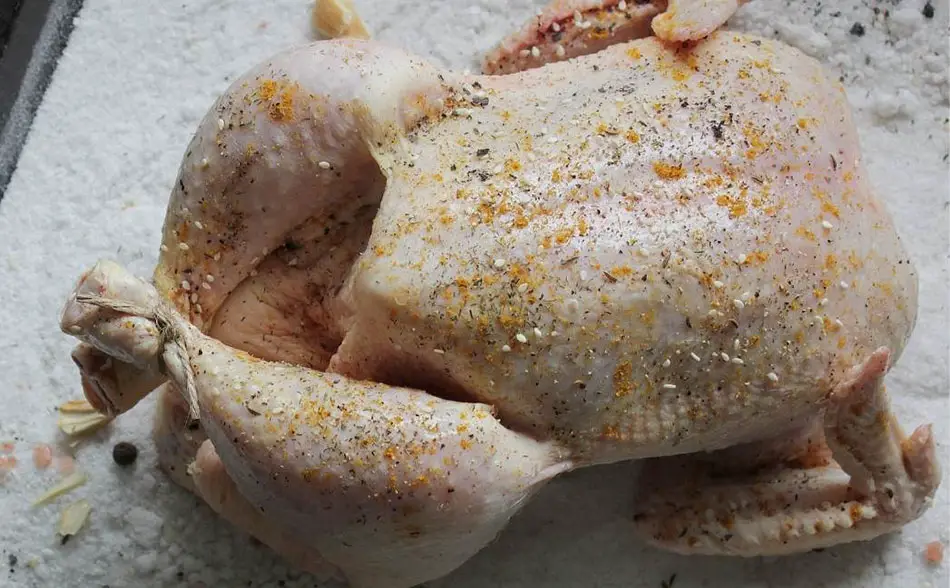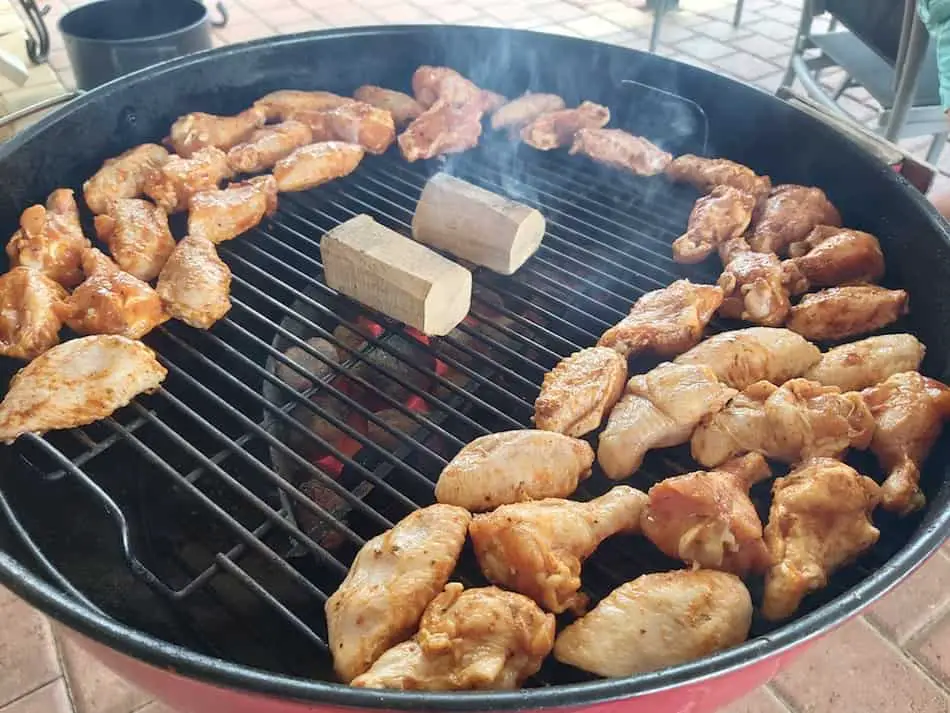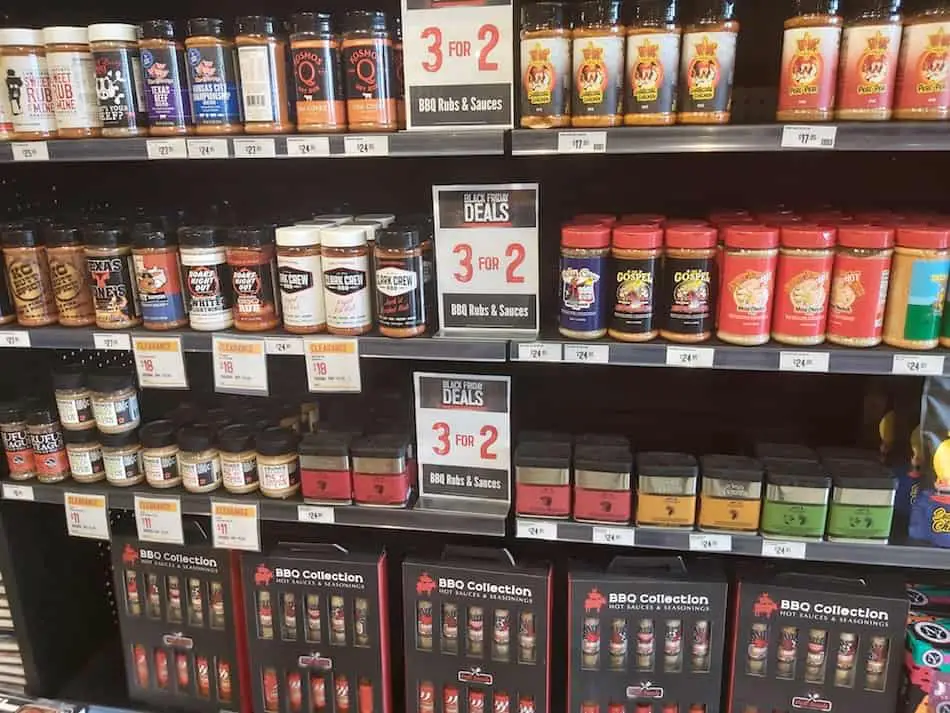
When smoking chicken, the rub is an important layer of flavor. When smoking meat, it’s all about building layers of flavor. You got one layer of flavor from the smoke and another from the barbecue rub. But with so many options on the market, how do you choose the right one? We asked expert barbecue pitmasters, competition pitmasters, celeb chefs, and food critics to share their tips and recommendations for selecting and using rubs on chicken. In this post, I’ll show you the best rubs on the market, plus I’ll walk you through a step-by-step homemade rub recipe that’ll make your chicken taste amazing.
When choosing a rub, it is important to look for one with a balance of sweet and savory flavors and a good mix of spices, such as paprika, garlic, and onion. A rub with a nice, coarse texture will also help create a crust on the surface of the chicken. To apply the rub, use a generous amount and make sure it is evenly distributed over the surface of the chicken. Pat it down firmly to ensure it sticks to the surface.
The Best Pre-Made Chicken Rubs on the Market
| Product | Maker | Ingredients | Price |
|---|---|---|---|
| Killer Hogs | Malcolm Reed | Brown sugar, paprika, salt, spices, dehydrated garlic, dehydrated orange peel, natural flavors, and less than 2% dry calcium phosphate added to prevent caking | $20 |
| Slap Yo’ Daddy All-Purpose Rub | Harry Soo | Sea salt, cane sugar, garlic, chili powder, paprika, cumin, chipotle powder, black pepper, Rosemary, Cayenne pepper, rice concentrate, spices, parsley flakes, and natural flavors | $20 |
| Butcher BBQ | Dave Bouska | Sugar, salt, garlic, onion, spices, lemon, powder, corn syrup, solids, natural flavors, and BHA as an antioxidant | $20 |
| Meat Church | Sugar, salt, spices, paprika, dextrose, dehydrated garlic, celery, silicon dioxide, spice extra foods, and is gluten-free | $15 | |
| Kosmos Killer Bee Rub | Sugar, salt, honey powder, refined syrup, honey, and spices, including paprika, dextrose, dehydrated garlic, and celery | $16 |
What Makes a Good Chicken Rub?
Rubs are an essential component of smoking chicken, adding flavor and texture to the final dish. But with so many options on the market, how do you choose the right one? We asked expert barbecue pitmasters, competition pitmasters, celeb chefs, and food critics to share their tips and recommendations for selecting and using rubs on chicken.
First, let’s define what a rub is. According to barbecue expert and competition pitmaster Harry Soo, a rub is “a blend of spices, usually in the form of a dry mix, that is applied to the surface of meat before cooking.” Soo, who is the owner of Slap Yo’ Daddy BBQ and a multiple barbecue world champion, recommends using a rub on chicken for “added flavor and to create a nice crust on the surface.”
But which rub should you choose? Malcolm Reed, the owner of Killer Hogs BBQ and the creator of the award-winning Killer Hogs rub, suggests looking for a balance of sweet and savory flavors. “I like to use a rub on chicken that has a good mix of sugar and spices,” Reed says. “The sugar helps to caramelize the skin and creates a nice crust, while the spices add flavor.”
Dave Bouska, the owner of Butcher BBQ and a winner of multiple barbecue championships, also emphasizes the importance of using a rub that complements the natural flavors of the chicken. “I like to use a rub that has a good balance of sweet and savory flavors and complements the taste of the chicken,” Bouska says. “I also look for a rub that has a good mix of spices, such as paprika, garlic, and onion, to add depth of flavor.”
Celeb chef and BBQ Pitmasters judge Melissa Cookston recommends using a rub that has a good blend of spices, including sweet, savory, and aromatic flavors. “I like to use a rub on chicken that has a good balance of sweet and savory flavors, as well as aromatic spices like garlic and onion,” Cookston says. “A rub with a blend of spices will add depth of flavor and create a nice crust on the surface of the chicken.”
Food critic and BBQ expert Jon Bonnell also suggests using a rub with a good balance of flavors, as well as one that has a nice texture. “I like to use a rub on chicken that has a good balance of sweet and savory flavors and a nice, coarse texture,” Bonnell says. “A rub with a coarse texture will help to create a nice crust on the surface of the chicken and add flavor.”
In terms of application, Soo recommends using a generous amount of rub on the chicken and patting it down firmly to ensure it sticks to the surface. “I like to use a generous amount of rub on the chicken and pat it down firmly to ensure it sticks to the surface,” Soo says. “This will help to create a nice crust on the surface and add flavor to the chicken.”
Reed agrees, stating that it is important to use a good amount of rub and to make sure it is evenly distributed over the surface of the chicken. “I like to use a good amount of rub and make sure it is evenly distributed over the surface of the chicken,” Reed says. “This will help to create a nice crust and add flavor to the chicken.”

Why Are My Chicken Wings Soft? – 10 Ways To Get Crispy Chicken Skin
Top 5 Pre-Made Rubs On The Market
I’ve done extensive research, tried a lot of products, been on all the forums, and narrowed down the best five rubs on the market. You can get these on Amazon, and they are produced with award-winning recipes. I guarantee you cannot go wrong with any of these products.
1. Killer Hogs: My number one choice of store port rubs is Killer Hogs. This is a championship-winning rub made by barbecue guru Malcolm Reed. You may have seen Malcolm’s YouTube channel; it’s the number one YouTube channel on barbecue called “How to barbecue right.”
Malcolm’s killer hogs rub goes on everything. It comes in a 12 oz shaker. Its ingredients include brown sugar, paprika, salt, spices, dehydrated garlic, dehydrated orange peel, natural flavors, and less than 2% dry calcium phosphate added to prevent caking. Malcolm’s rub costs $20 on Amazon. Check it out here:
2. Slap Yo’ Daddy All-Purpose Rub: Again, this rub is made by a barbecue guru. But not just any barbecue guru. It’s the great Harry Soo. Harry is a multiple barbecue world champion, and now he is sharing his secrets with his line of rubs. This works well with chicken and contains sea salt, cane sugar, garlic, chili powder, paprika, cumin, chipotle powder, black pepper, Rosemary, Cayenne pepper, rice concentrate, spices, parsley flakes, and natural flavors. Harry’s rubs cost $20 on Amazon.
3. Butcher BBQ: This is an outstanding championship rub made by barbecue guru Dave Bouska. They featured on the TV show BBQ Pitmasters and won a world championship. Famous for making brisket marinades, Butcher BBQ also makes a high-quality rub in a 16 oz shaker. It contains sugar, salt, garlic, onion, spices, lemon, powder, corn syrup, solids, natural flavors, and BHA as an antioxidant. Butcher BBQ sells for $20 on Amazon.
4. Meat Church: This company is gaining in popularity and has now become a well-respected name in barbecue with this Southwestern-style rub. The Holy Gospel works well on beef, chicken, pork, and seafood. This contains sugar, salt, spices, paprika, dextrose, dehydrated garlic, celery, silicon dioxide, spice extra foods, and is gluten-free. It cost $15 on Amazon. Check it out here:
5. Kosmos Killer Bee Rub: This award-winning rub is sweet and savory, and works well on chicken brisket and pork. It comes in a 13-ounce shaker and contains sugar, salt, honey powder, refined syrup, honey, and spices, including paprika, dextrose, dehydrated garlic, and celery. It cost $16 on Amazon. Check it out here:

Making Your Own Rubs
You shouldn’t be intimidated by making your own barbecue rub. I used to be intimidated, so I would buy Malcolm Reed’s or Harry Soo’s rub. I didn’t have the confidence to make my rub, especially when cooking or smoking for other people. But once I found a couple of good rub recipes, I haven’t looked back.
Standard Barbecue Rub

I found this great rub recipe through How To BBQ Right. I use this recipe and alter it slightly depending on what I'm cooking. Made by the guys at Townsend Spice & Supply: https://townsendspice.com/
Ingredients
- - ½ Cup Paprika
- - ½ Cup Salt
- - ½ Cup Sugar
- - ½ Cup Granulated Garlic
- - ¼ Cup Granulated Onion
- - ¼ Cup Chili
- - ¼ Cup Cumin
- - 2 Tablespoons Black Pepper
- - 2 Tablespoons Dry Mustard
- - 1 Tablespoon Cayenne Pepper
Instructions
- Combine all the spices together in a large mixing bowl
- Store rub in rub shakers
Aaron Franklin Rub
Just follow Aaron Franklin’s salt and pepper rub if you want to keep your rub simple. Aaron uses a Texas-style rub, a coarse black pepper and kosher salt. Aaron is a big believer in letting the meat’s natural flavors be the star of the show rather than the rub.
Aaron uses a 16-mesh coarse black pepper and Morton’s kosher salt. He uses a 50/50 ratio and combines some in a bowl or a shaker. Franklin often mixes in a little paprika for color, especially when he’s making a rub for pork, chicken or poultry. Aaron sometimes mixes in onion granules for the texture and some garlic powder for a more savory taste.
Basic BBQ Rub Recipe
- Half a cup of paprika
- Half a cup of salt
- Half a cup of sugar
- Half a cup of granulated garlic
- 1/4 cup of granulated onion
- 1/4 cup of chilli
- 1/4 cup of cumin
- 2 tablespoons of black pepper
- 2 tablespoons of dry mustard
- 1 tablespoon of cayenne pepper
You can make different variations of the above rub. If you’ve got a few different shakers, just separate them into four different categories. Have one that has less spice, one that has less salt or no salt, one that has less sugar, and one that follows the recipe.
Beef rubs are not high in sugar but have savory flavors. Beef also does well with a bit of spice and savory flavors, such as onion, garlic, paprika, cumin, etc.
Pork and chicken do better with sweeter rubs, and often you’ll find sugar mixed into these rubs. If you want to use a sugar that doesn’t burn, use turbine sugar, which has a higher heat threshold. So be careful with sugary rubs because they will burn.
Make Rubs in Large Batches
It’s good to make different variations of the above rub recipe and store them in different shakers. I always make a couple of different batches. The first batch I will usually make a standard rub following the above recipe. Even though it’s quite spicy and contains salt, I like having an all-in-one rub that’s ready-to-use on anything.
The second version of the rub I make is without salt. Sometimes if I’m brining brisket separately, so I don’t want to have salt in my rub. I like to salt my meat separately, especially brisket, but I’ll also do the same for chicken and turkey. Often with turkey or chicken, I may want to marinate it or soak it in a brine, so I need to control the salt.
The third batch of rub I make contains little or no sugar. A sugary rub works well with chicken and pork, but sweet tones don’t blend well with beef such as brisket.
The next batch I make is low on chilli and spice. I often cook for the whole family, so I want to go easy on the spice for the kids. The above rub recipe contains a lot of paprika, canine pepper, chilli powder, etc, so it can get pretty hot.
Binders and Slather
Often, before we put rub on our chicken or any meat, it’s good to apply a binder. This is so the rub sticks to the meat. If the meat is dry, the rub will not stick, and you’re going to have a patchy external crust on your meat. If you want to have a nice bark on your meat, including your chicken, you want the rub to stick on every part of the mate. A binder or a slather will help the rub stick.
If you have parts of the meat where the rub doesn’t stick, you’ll have a patchy bark. Apply a binder using olive oil, yellow mustard, or plain water. I find olive oil works best, although many people use yellow mustard. With chicken, I would use olive oil, not yellow mustard.
Final Thoughts
To put it simply, a rub is just a blend of spices that you apply to the surface of the meat before you cook it. It’s a great way to add flavor and create a nice crust on the surface of the chicken.
When it comes to choosing a rub, I like to look for something that has a good balance of sweet and savory flavors. You want something that’s gonna complement the natural flavors of the chicken, not overpower them. I also like to find a rub that has a good mix of spices – something with paprika, garlic, and onion will add some depth of flavor.
As far as application goes, I like to be generous with the rub. I’ll sprinkle it all over the chicken and then pat it down firmly to make sure it sticks to the surface. You want to make sure you have an even distribution of the rub, so every bite has that nice, flavorful crust.
My Favorite Meat Smoking Tools
Thanks for checking out this article. I hope you learned a few things. Here are some of my favorite tools I use when smoking brisket that may be useful to you. These are affiliate links, so if you decide to purchase any of these products, I’ll earn a commission. But in all honesty, these are the tools I recommend to my family and friends who are just starting out.
Meat Thermometer: There are dozens of fancy thermometers on the market, but I still use my trusty TP20. For around $50, I have a high-quality meat thermometer with two probes, and can track the temperature of my smoker with one probe, and my meat with the other probe. The ThermoPro TP20 is an Amazon Best Seller because it’s the easiest thermometer to operate, is durable, highly accurate, and comes with pre-programmed meat settings.
Instant Read Thermometer: Arguably, the second most important tool you need is a fast and accurate instant-read thermometer. These tools play an important role in the latter stages of the cook when the meat needs regular checking in multiple areas. I use the ThermoPro TP19 because it can do everything a ThermaPen can do, but for a fraction of the cost. You can check out the TP19 on Amazon here.
Wireless Thermometer: The latest thermometers on the market have no wires and can be controlled by wi-fi via your phone. Airprobe 3 is the best of this technology.
Butcher Paper: Wrapping brisket in butcher paper has become a huge trend in barbeque thanks to Aaron Franklin. Wrapping your brisket in paper will give you a nice brisket bark. However, you can’t just use any old paper, it has to be unwaxed, food grade paper. You can find it on Amazon here.
Advanced Thermometer and Automatic Temperature Controller: Once you’re ready to take things seriously, the FireBoard 2 Drive is a six-channel Bluetooth/Wi-Fi thermometer that can monitor up to 6 pieces of meat, control and graph your cook sessions on your smartphone, and attaches to an an automatic blower that will convert your charcoal smoker to a set-and-forget. This is one of the most advanced meat thermometers on the market. You can check it out on the FireBoard website here.

